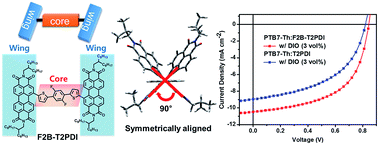Geometrically controlled organic small molecule acceptors for efficient fullerene-free organic photovoltaic devices†
Abstract
Organic small molecule (SM) acceptors containing a perylene diimide (PDI) moiety, F2B-T2PDI and T2PDI are synthesized, and the effects of their molecular geometry on the performance of fullerene-free organic photovoltaic (OPV) devices are investigated. The SM acceptors possess a PDI–core–PDI structure in which the PDI wing is connected to conjugated core units. By incorporation of a 2,5-difluorobenzene (F2B) moiety within the core unit, the planarity of the conjugated core is enhanced and the energy levels of the SM acceptor are down-shifted. In terms of molecular geometry, the F2B-containing SM acceptor, F2B-T2PDI, has a rigid core, which can symmetrically align the two PDI wings and enhance molecular packing. As a result, improved electron transport and bulk heterojunction morphology of the active layers are achieved. Furthermore, the incorporation of the F2B moiety effectively down-shifts the HOMO energy level, preventing back-transfer of holes from the acceptor to the cathode and enhancing the absorption of complementary wavelengths of the donor polymer, PTB7-Th. Leveraged by the beneficial geometric and energetic effects from the incorporation of F2B units, the power conversion efficiency of fullerene-free OPV devices using F2B-T2PDI reached 5%, whereas that using T2PDI was 3.63%.


 Please wait while we load your content...
Please wait while we load your content...